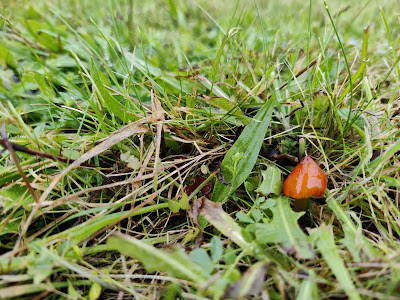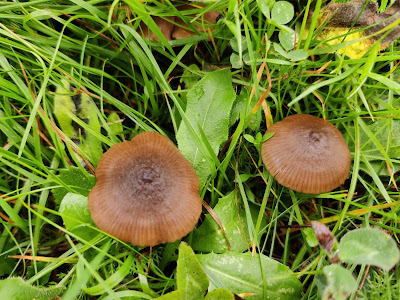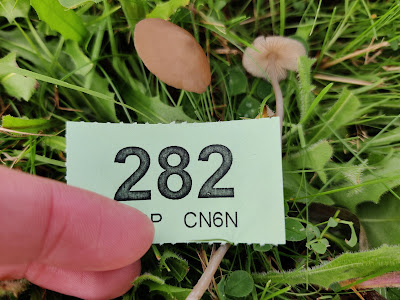I was asked to take a look at an East Sussex cemetery this week, after a local ecologist noticed it was looking very waxcappy and OH MY GOODNESS, was it waxcappy!!!
I make it fourteen species of waxcaps recorded on today's visit. Considering the threshold for consideration for SSSI status is 19 species (which would typically be recorded over multiple visits, over several years), that's pretty darn waxcappy! This site will certainly qualify as being of at least regional importance for its grassland fungi assemblage, based on what I've seen today. Here's a quick list (all photos taken on site today):
1. Pretty sure this is Spangle Waxcap Hygrocybe insipida, with the translucent, striate cap. I don't always see it with such decurrent gills, but it is a very variable species and the gills can be deeply decurrent, according to Boertmann.
I've got this one down as H. insipida too, with that red top to the stipe. But I'm open to correction! H. insipida is so variable it can be a bit bamboozling at times.
2. Snowy Waxcap Cuphophyllus virgineus. Classic snowy. Loads of these around.
3. Butter Waxcap Hygrocybe ceracea. Note the consistently yellow tones, adnate gills and more diminutive stature compared to the next species.
4. Golden Waxcap Hygrocybe chlorophana. You can see from the shine on these how viscid they are. Note the adnexed gills.
5. Slimy Waxcap Gliophorus irrigatus. Very fresh and so slimy they were almost impossible to pick up!
6. Scarlet Waxcap Hygrocybe coccinea. Beautiful.
There were SO MANY of these. The photos don't do them justice.
7. Blackening Waxcap Hygrocybe conica
Also popping up here near some H. chlorophana...
8. Pink Waxcap Porpolomopsis calyptriformis - a high diversity indicator. Around four fruit bodies in total. I liked the very delicate pink colour on these.
9. Crimson Waxcap Hygrocybe punicea - a high diversity indicator. Stunning mushrooms.
10. Yellow-foot Waxcap Cuphophyllus flavipes - a high diversity indicator. Very fine specimens showing their yellow feet nicely.
11. Honey Waxcap Hygrocybe reidii. Reckon I definitely got the honey-like smell with these, and the colour is quite distinctive.
12. Neohygrocybe sp.? - a high diversity indicator. I'm still puzzling over this one but I'm thinking either N. ingrata, with those orangey-brown tones, or possibly N. nitrata? I thought maybe I could detect a faint nitrous smell but I'm not great with smells.
I've looked for reddening in the flesh (typical of N. ingrata) but I'm not convinced I'm seeing it.
13. Parrot Waxcap Gliophorus psittacinus
Some pretty tawny-coloured ones (showing a little bit of green if you looked hard enough).
... and some pinkish ones. Never get bored of the colours on these.
14. Meadow Waxcap Cuphophyllus pratensis.
I think these were just starting to show. Made me wonder if any other species will be on their way here, later in the season?
X. Hygrocybe sp. I'm not sure about.
The dry cap and that shade of orange are making me think H. reidii but I couldn't get the honey smell with these and I've never seen them growing so tall in a clump like this. So not sure if these are H. reidii but don't know what else they could be...
Also Meadow Coral Clavulinopsis corniculata, growing here with a teeny tiny Meadow Waxcap C. pratensis.
And a couple of patches of Smoky Spindles Clavaria fumosa.
Plus some yellow clubs and spindles which I haven't attempted to tackle. The diversity on this site was a bit overwhelming! Reckon I must have seen at least four different Clavarioid species today.
What a show!
For the record
Date: 30 October 2021
Records will be submitted via iRecord in due course.
































































